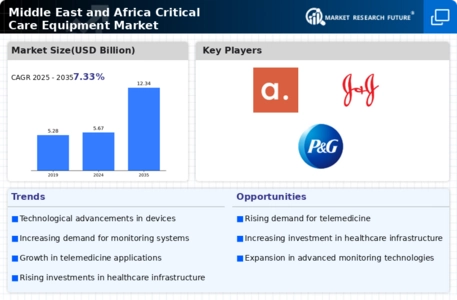Growing Aging Population
The aging population in the Middle East and Africa is a key driver of the Global Middle East and Africa Critical Care Equipment Market Industry. As the demographic shifts towards an older population, the prevalence of age-related health issues increases, necessitating advanced critical care solutions. This demographic trend compels healthcare providers to invest in critical care equipment to address the specific needs of elderly patients. The market's growth is further supported by the increasing awareness of the importance of specialized care for this demographic, which is likely to drive demand for equipment such as ICU beds and monitoring devices, ensuring that healthcare systems are adequately prepared.
Market Growth Projections
The Global Middle East and Africa Critical Care Equipment Market Industry is poised for substantial growth, with projections indicating a rise from 5.67 USD Billion in 2024 to 12.34 USD Billion by 2035. This growth trajectory reflects a compound annual growth rate (CAGR) of 7.33% from 2025 to 2035, underscoring the increasing demand for critical care equipment. Factors contributing to this growth include advancements in medical technology, rising healthcare expenditure, and a growing aging population. As healthcare systems evolve to meet the challenges of modern medicine, the market is likely to expand, driven by the need for innovative and effective critical care solutions.
Increasing Healthcare Expenditure
The Global Middle East and Africa Critical Care Equipment Market Industry is significantly influenced by rising healthcare expenditure across the region. As governments and private sectors allocate more resources to healthcare, the demand for critical care equipment is expected to surge. This increase in expenditure allows healthcare facilities to upgrade their equipment and adopt new technologies, thereby improving patient care. The projected compound annual growth rate (CAGR) of 7.33% from 2025 to 2035 indicates a robust growth trajectory, as investments in critical care equipment become a priority for healthcare systems aiming to enhance service delivery and patient outcomes.
Government Initiatives and Funding
Government initiatives play a crucial role in shaping the Global Middle East and Africa Critical Care Equipment Market Industry. Many countries in the region are prioritizing healthcare infrastructure development, leading to increased funding for critical care equipment. For example, various governments are implementing policies that promote the acquisition of advanced medical devices, which is likely to enhance the availability of critical care resources. This support is essential for improving healthcare delivery and ensuring that facilities are equipped to handle emergencies. As a result, the market is anticipated to grow significantly, with projections indicating a rise to 12.34 USD Billion by 2035, driven by these initiatives.
Emerging Technologies in Critical Care
Emerging technologies are reshaping the Global Middle East and Africa Critical Care Equipment Market Industry, offering innovative solutions that enhance patient care. The integration of artificial intelligence, telemedicine, and remote monitoring systems is becoming increasingly prevalent in critical care settings. These technologies not only improve the efficiency of healthcare delivery but also enable better patient outcomes through real-time data analysis and remote consultations. As healthcare providers recognize the benefits of these advancements, investments in such technologies are expected to rise, contributing to the overall growth of the market. This trend aligns with the projected increase in market size, indicating a shift towards more technologically advanced critical care solutions.
Rising Demand for Advanced Medical Technologies
The Global Middle East and Africa Critical Care Equipment Market Industry experiences a notable increase in demand for advanced medical technologies. This trend is driven by the growing prevalence of chronic diseases and the need for sophisticated monitoring and treatment solutions. For instance, the market is projected to reach 5.67 USD Billion in 2024, reflecting a shift towards high-tech equipment that enhances patient care. Hospitals and healthcare facilities are increasingly investing in innovative technologies, such as ventilators and patient monitoring systems, to improve outcomes and efficiency. This demand is expected to continue, as healthcare providers seek to adopt cutting-edge solutions to meet patient needs.







Leave a Comment